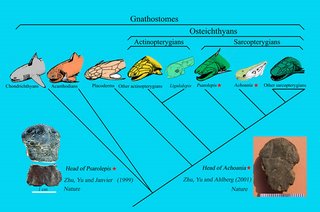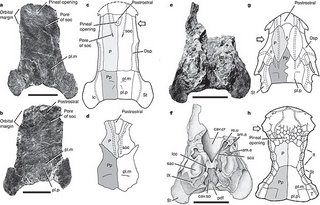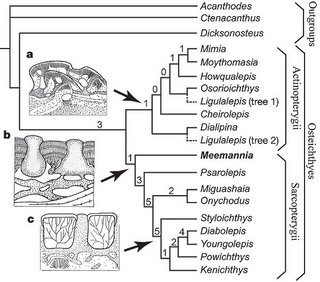Friday, June 30, 2006
More on the Origins of Lobe-finned (Sarcopterygian) Fish in China
Gone Fishing
Published online: 01 March 2001; | doi:10.1038/news010308-2
Our fishy ancestors shed some ancient excess baggage.
How vertebrates evolved from splashing about in ancient seas and lakes to strolling along the beach on a Sunday afternoon is a question of abiding interest to biologists, and takes an odd turn in a study of fossil fishes published this week1.
The research, by Per Erik Ahlberg of the Natural History Museum in London and colleagues, describes the discovery of a primitive and ancient fossil lobe-finned fish, and sheds light on a bizarre early episode in the evolutionary history of modern vertebrates.
Being land animals, our view of what's important in life is somewhat skewed. The fact is that the vast majority of vertebrates (animals with backbones) are those that we don't see very often -- fishes. Humans and most of the land animals we're familiar with (dogs, cats, horses and so on) can be seen as fishes that have become specialized for living out of water. To do this, their fins have become elaborated into legs.
Land vertebrates belong to a group of fishes called the lobe-finned fishes, or sarcopterygians. Sarcopterygians were once widespread, especially during the Devonian Period (408-362 million years ago), the so-called 'age of fishes'. But now only the land vertebrates, lungfishes and coelacanth survive.
Biologists have been particularly interested in studying the sarcopterygians because they are our aquatic forebears. How did they diverge from actinopterygians, the ray-finned bony fishes? And how are bony fishes as a whole related to other vertebrates such as sharks and exotic, extinct fishes such as placoderms and acanthodians?
The work by Ahlberg's team has caused quite a bit of surprise.
The researchers describe a very primitive sarcopterygian called Achoania from 400-million-year-old rocks in Yunnan in southern China. Remarkably, there is evidence that the eyes of this fish were held in place by stalks of tough connective tissue. This finding was something of a surprise because eyestalks are unknown in sarcopterygians, or indeed any bony fish alive today. But they are typical of sharks, which went down a separate branch on the tree of life millions of years before.
Ahlberg's team also find evidence for eyestalks in a previously known fossil sarcopterygian called Psarolepis This fish, which comes from rocks in Yunnan of similar age to those that yielded Achoania was once thought to have been an unremarkable sarcopterygian, if a rather primitive one. But further work2showed that Psarolepis had many features, such as prominent spines associated with its fins, that are very un-sarcopterygian, and more associated with acanthodians, placoderms and early sharks. What's more, work on a still-unnamed braincase of a primitive actinopterygian from Australia showed that it, too, may have had eyestalks3.
Three lessons can be learnt from the discoveries. First, that the ancestors of bony fishes in general, and sarcopterygians in particular, spent some time shedding primitive features characteristic of fishes in general before diversifying into a range of forms -- one of which gave rise to the land vertebrates. Second, that many features thought to have been specializations of archaic creatures such as acanthodians and placoderms had a more general distribution among vertebrates.
Finally, the work suggests that the Yunnan region of southern China was the birthplace of sarcopterygians, and therefore of the tetrapods, which include land vertebrates like ourselves. Some 400 million years ago, Yunnan and adjacent parts of Vietnam formed an isolated continent, a 'Garden of Eden' that saw the initial stages of sarcopterygian evolution.
References
- Zhu,M., Yu, X. & Ahlberg, P. E.A primitive sarcopterygian fish with an eyestalk Nature 410,81 - 842001. | Article | PubMed | ChemPort |
- Zhu,M., Yu, X. & Janvier, P. A primitive fossil fish sheds light on the origin of bony fishes. Nature 397,607 - 6101999. | Article | ChemPort |
- Basden,A. M.,Young, G. C.,Coates, M. I.& Ritchie, A. The most primitive osteichthyan braincase? Nature 403,185 - 1882000. | Article | PubMed | ChemPort |

The Chinese Evidence for the Evolutionary Origins of Fish
In this post we’ll discuss the origins of the modern class of boney fish, which as we will see is directly relevant to our own ancestry. First off I’ll present a basic review of fish systematics. There are three extant classes of aquatic vertebrates generally referred to as “fish.” These include the jawless lampreys and hagfish (class Agnatha), the cartilaginous sharks and rays (class Chondrichthyes) and the aforementioned boney fish (class Osteichthyes). The boney fish are further divided into the familiar ray-finned fish (subclass Actinopterygii) and the lesser known lobe-finned coelacanth and lungfish (subclass Sarcopterygii). The actinopterygians are dominated by the teleosts, which include all living boney fish other than sturgeon, gars and their allies. The fossil record of fish is replete with many extinct groups belonging to all the above taxa as well as many other higher order taxa that have since gone extinct (such as placoderms, and acanthodians).
One of the major issues in the evolution of boney fish is the relationship between the ray-finned actinopterygians and the lobe-finned sarcopterygians. When and where did their divergence take place and what were the morphologic characteristics of the common ancestor of these two major groups of fish? This divergence event has a direct bearing on our own evolution as well. Systematically Osteichthyes is a paraphyletic taxon in that it does not contain all the descendants of the common ancestor referred to above. This is due to the fact that the lobe-finned sarcopterygians are the evolutionary source for the terrestrial tetrapods, the four-limbed vertebrates that include amphibians, reptiles and mammals, hence our very origins are tied to the evolutionary split between ray-finned and lobe-finned fish. In this regard the recent announcement by Chinese scientists of a fossil species that had aspects of both extant suborders of boney fish discussed above, which lived more than 405 million years ago in southern China, sheds new light on the origin of the very evolutionary lineage that eventually gave rise to modern human beings.
Zhu Min and his team of researchers at the Institute of Vertebrate Paleontology and Paleoanthropoly, Chinese Academy of Sciences (CAS), originally found the fossils of the ancient fish in 2001 and 2002 at Qujing in Southwest China's Yunnan Province. In the following three years, Zhu and his colleagues discovered more remains that confirmed that this ancient species provides a link between the ray-finned and lobe-finned fish that followed. Zhu and his fellow researchers called it Meemannia eos which translates as “Miman’s Dawn Fish," in honor of the famed Chinese paleontologist Md. Zhang Miman, an academic at the Chinese Academy of Sciences. Its discovery is an exciting step forward for research into the evolution and diversification of ancient fish and other vertebrates.
Martin Brazeau, over at The Lancelet, discusses this transition based on the recently described Chinese fossil Meemannia eos, and rather than reiterate his comments I present them in full below:
“I guess one can't really talk about an evolution transition having 'ends', since one might even consider the origin of vertebrates as a whole to be part of the origin of tetrapods story. However, we focus a lot on the transformation from sarcopterygian (lobe-finned) fishes to the earliest tetrapods like Acanthostega and Ichthyostega. Lest we forget the origin of the sarcopterygians themselves. This is a murky and poorly understood part of vertebrate evolution where the fossils are limited to what we affectionately call "thumbnail skulls". These are usually braincases and associated snouts that aren't much bigger than, well, your thumbnail (and kind of shaped like them too).
This 405-Myr-old fish shows a mixture of basal actinopterygian and sarcopterygian features. a, b, Dorsal view of skull roof (a, holotype, V14536.1; b, V14536.2). e, f, Ventral view of posterior portion of the skull roof with incompletely preserved oto-occipital structures (e, V14536.4; f, illustrative drawing). c, d, g, h, Reconstruction of skull roof (c) compared with two actinopterygians, Dialipina (d) and Cheirolepis (g), and one sarcopterygian, Powichthys (h). Abbreviations: am.a, am.e, anterior and external ampullae; cav.cr, cranial cavity; cav.so, supraotic cavity; Dsp, dermosphenotic; It, intertemporal; lc, otic portion of the main lateral line canal; lcc, lateral cranial canal; P, parietal; pdf, posterior dorsal fontanelle; pl.m, pl.p, middle and posterior pit-lines; Pp, postparietal; re.u, utricular recess; sac, sacculus; sca, anterior semicircular canal; soc, supraorbital canal; St, supratemporal; T, tabular; IX, exit of the ninth cranial nerve. Open arrow in c, g and h indicates the position of the orbit. Scale bar, 5 mm (a, b, e, f). From Zhu et al. 2006.
“In recent years, we have seen the publication of a number of really peculiar thumbnail skulls from China, nearly all of which belong to some kind of sarcopterygian. One of the defining features of the sarcopterygian skull is a joint that runs right through the braincase. The only living sarcopt to retain such a feature is the modern coelacanth. However, once upon a time in the Devonian, most sarcopterygians were built this way. We know these skulls are sarcopterygian because of this division of the skull and braincase, as well as the histology of the dermal bone. Sarcopterygians are unique in having had a system of pores and canals running through an enamel-like layer on the outside. This tissue matrix is called cosmine. One will often hear of "cosmine-covered osteolepiforms" or "cosmine covered sarcopterygians", to distinguish these forms from taxa that later lose cosmine (for instance, the loss of cosmine is a character that Tiktaalik shares with tetrapods).
“But apart from these defining features of sarcopterygians, the thumbnail skulls from China also have a strange mélange of characters from all kinds of other fish groups: actinopterygian (ray-finned) fishes, sharks, placoderms, and acanthodians. For instance, it was recently noted that several of these taxa had the bony facet for the attachment of an eyestalk -- a cartilage rod found in some modern sharks that supports the eyeball. Similar facets have been seen in fossil shark braincases and later in ray-finned fish braincases. Psarolepis, for instance, was shown to have a cheek very similar to that of an actinopterygian and it even had a spine on a shoulder girdle that was associated with the skull. The actual identity of some of these parts, however, may be disputed because we still haven't got whole skeletons of these fishes.
“Today (5-04-06) in Nature a new piece is added to this puzzle: Meemannia eos. This new taxon is peculiar as far as sarcopts go. It has something sort of like cosmine, but somewhat more rudimentary. However, another interesting aspect is the absence of an intracranial joint, like the one described above.“Immediately, one is faced with two options: was the joint lost or was it simply primtive? The answer appears to be the latter, and that Meemannia is the most primitive sarcopterygian known to date. The skull roofing bones of Meemannia are curiously similar to those of primitive ray-finned fishes. In fact, the authors note, the snout appears to have been loosely attached to the rest of the skull, a feature also seen in placoderms. The weight of the evidence appears to support the conclusion that Meemannia is a rather 'primitive' animal.
The figure is based on two most parsimonious trees that differ in the positions of Ligulalepis. Bremer support values are shown at nodes. Tree length 222, consistency index 0.6216, homoplasy index 0.3784, retention index 0.7807, rescaled consistency index 0.4853. See Supplementary Information for details. Insets compare the histological features of Meemannia (b) with those found in actinopterygians (Andreolepis, a) and crown-group sarcopterygians (Porolepis, c). From Zhu et al. 2006“Furthermore, I mentioned that it had cosmine or something very much like it. The authors note that what we see in Meemannia the cosmine structure is unique among sarcopterygians and offers some clues about its natural history. In previous decades, the pore-canals have been suggested to represent a system something like the ampullae of Lorenzini in sharks. This is a network of electrosensory organs that sharks have spread over their faces, and the networks of the ampullae are quite similar to that seen in cosmine. Of course, cosmine-covered sarcopterygians are all extinct and we have no way of knowing what the function of the cosmine canals and pores were for. However, the new fossil suggests a rather different function: growth. Unlike the cosmine of other sarcopterygians, but somewhat like the enamel tissue of actinopterygians, the cosmine of Meemannia grew by the addition and expansion of layers. This suggests that Meemannia's cosmine growth is more primitive. Furthermore, this unique mode of growth suggests that he pore-canals may be a vascular system that supprted this, and may not necessarily have been for sensory purposes. However, I don't see these options as neccessarily exclusive, so I'm not sure if we can really rule out a sensory function just yet.
“Meemannia is another addition to the story of the early evolution of bony vertebrates. It's another clue about how this event proceeded and how the two major lineages of bony vertebrates emerged. We still need a lot more clues and a lot more work to figure out the details, but the fossils from China are (once again) helping to disperse the fog.”
Also worth a mention here is that Meemannia eos is named after the renowned vertebrate palaeontologist Chang Mee-mann for her enormous contribution to vertebrate palaeontology, especially in China. Her influence on palaeoichthyology has been enormous and she is easily one of the most respected contributers to the field of early vertebrate and early fish evolution.
Zhu, M. et al. 2006. A primitive fish provides key characters bearing on deep osteichthyan phylogeny. Nature 441: 77-80. <link>
See also:
Basden, A.M. et al. 2000. The most primitive osteichthyan braincase? Nature 403: 185-188. <link>
Zhu, M. et al. 1999. A primitive fossil fish sheds light on the origin of bony fishes. Nature 397: 607–610. <link>
Zhu, M. et al. 2001. A primitive sarcopterygian fish with an eyestalk. Nature 410: 81–84. <link>
Wednesday, June 21, 2006
Pandas on the Mend?
 The giant panda is one of the world’s most endangered and elusive species. It is found only in a restricted mountainous region in China with an unusual dietary dependence on bamboos found only in these mountains. This elusive nature has shielded important knowledge needed to save it from extinction, until now. (Image courtesy of Cardiff University)
The giant panda is one of the world’s most endangered and elusive species. It is found only in a restricted mountainous region in China with an unusual dietary dependence on bamboos found only in these mountains. This elusive nature has shielded important knowledge needed to save it from extinction, until now. (Image courtesy of Cardiff University)
Despite recently expressed concerns for the survival of the Giant Panda due to persistent problems associated with habitat destruction (see Nature Reserves Aren't Protecting Pandas, Study Shows; April 6, 2001) and attempts to increase Giant Panda numbers by artificial means (see Researcher Says Panda Cloning "Worth The Risk", July 7, 1999), it may have a brighter future than previously thought. The following account documents the results of a recent survey of giant panda numbers taken by a joint Sino-Canadian scientific team.
“Scientists at Cardiff University, using a novel method to estimate population, have found that there may be many more giant pandas remaining in the wild than previously thought. Understanding population trends for giant pandas has been a major task for conservation authorities in China for the past thirty years, during which time three national surveys were carried out. The first two revealed alarming evidence of decline in the numbers of giant pandas. However, the most recent survey, carried out in 2002, showed the first evidence of a recovery, thanks largely to protection measures taken by the Chinese government including a network of natural reserves and strictly enforced bans on poaching and deforestation.
"However, given the variable accuracy of traditional ecological population recording methods, scientists from Cardiff's School of Biosciences working with a team in China used a novel approach to accurately estimate population size. The results are published in the international journal Current Biology.
"The team led by Professor Michael Bruford, Cardiff School of Biosciences and Professor Fuwen Wei, Institute of Zoology, the Chinese Academy of Sciences used recently developed 'non-invasive' methods for counting wild animal populations to re-examine panda population estimates. This method profiles DNA from panda faeces to provide a more accurate population profile.
"Professor Bruford said: 'Our results found that previous surveys underestimated the population by more than 50%. These finding indicate that the species has a much better chance of long-term viability, although we must not become complacent, since the population size is still perilously low.'
"The scientists anticipate that these results are likely to be replicated in other key reserves indicating that there may now be many more giant pandas remaining in the wild than previously thoight."
This is of course very encouraging news, particularly for those of us who have a passing knowledge of Chinese prehistory. The giant panda is a conservationist icon and its study in the wild by George Schaller and Chinese colleagues (The Giant Pandas of Wolong) in the early 1980s was a clarion call for renewed efforts to save endangered species worldworld. The giant panda was a major faunal element throughout China south of the Qinling Mts. during the Pleistocene and ranged as far north as the "Peking Man" site during climatic optimums. It survives today as a relic of times gone-by, much as if the giant sloth or glyptodon had survived until today in the American southwest.
The giant panda is now known to be a true bear and not a member of the racoon family as long thought. Its relationship to the smaller red panda, which is regarded today by most systematists as closely tied into the basal radiation of mustelids and procyonids amongst the arctoid canrivorans, is thus paraphyletic. The term "panda" is, like the term "monkey" amongst Primates, purely gradistic in nature and doesn't represent a phylogentic clade. Both species , moreover, seemingly represent early, specialized offshoots of the respective clades to which they belong.
| |
Welcome to Sinanthropus
Sinanthropus - The genus name originally given to "Peking Man" by Davidson Black, is the title of this blog. It will focus on breaking news regarding the prehistory of China and adjacent regions of Asia. Over the past two decades China has become a major player in the unfolding story of organismic evolution here on planet Earth. From the very origins of life on earth, through the emergence of multicellularity, and the major phyla of plant and animal life, the fossil record being uncovered in China is unparalelled. Virtually every major form of life on earth seems to have its earliest representatives well-represented in the annals of Chinese prehistory, from Precambrian embryos, to the earliest chordates, primeval fish and amphibians, from feathered dinosaurs to early mammals and the first flowering plants, China has become center stage in the unfolding drama of the evolution of life on earth. My specialty has been the study of human evolution in east Asia and I will post extensively on that and related topics, as well as the whole gamut of studies relating to the natural history of China. My first posts will deal with recent finds. I will add posts on previous discoveries and their implications on a continuing basis.



